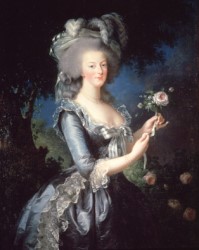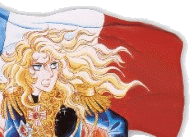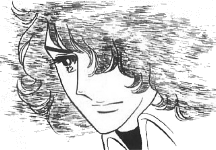|
||||||||||||||||||||||||||||||||
"Berusaiyu No Bara" (translation: "The Rose of Versailles") has been drawn by Riyoko Ikeda at the beginning of '70s. At those times, Riyoko Ikeda wasn't a professional mangaka, she was a young studend of story and philosophy: it seems that she decided to publish comics to gain some money by helself and going on studying music, dream of her life... |
||||||||||||||||||||||||||||||||
|
Riyoko Ikeda offered the first project of her comics to Shueisha; at that time, Shueisha Publishings was releasing a famous magazine for girls, called "Weekly Margaret", offering serializations of manga-comics by young artists. Many of the artists publishing their works on this magazine, they were students looking for success or simply for some extra personal gain. VERSAILLES NO BARA first project was not so much appreciated by publishers: Riyoko Ikeda was hoping for an historical manga about life of Marie-Antoinette, queen of France... such an argument seemed not suitable for young japanese women... european history was far... how could women love such a subject? Maybe a brand-new kind of character had to be created: OSCAR! She was!!
So "Berusaiyu no Bara" was not born to tell the story of Oscar Francois de Jarjayes... Oscar was only a mirror-character, something new to add to the real history of Marie Antoinette. The idea of a character like Oscar could come after the success of the Takarazuka Theatre, whom Ritoko Ikeda was great admirer, where women always played roles of men... we can think that this kind of culture could be one of the reasons of such choice. And more, a woman with men's clorhing wasn't a non-sense in French history because we know about women who were dressing and "acting" like men at the French Court... maybe just for fashion.
[On the left, one title-page from Weekly Margaret n.21, 21st
May 1972, showing the title of the really episode of
VERSAILLES NO BARA...
Riyoko Ikeda was only a bit more then a student at that time...
now she is absolutely the most loved author of the genre in
Japan... her fortune was starting from here! |
||||||||||||||||||||||||||||||||
|
BETWEEN 1972 AND 1974, BERUBARA SOLD 13.000.000 - 13 BILLIONS - COPIES !!! (numbers by Shueisha...) |
||||||||||||||||||||||||||||||||
BUT WHO IS ..."THE ROSE OF VERSAILLES"... ? |
||||||||||||||||||||||||||||||||
The "Rosa di Versailles" is Marie-Antoinette as for Riyoko Ikeda ... but someone else could think to Oscar! |
||||||||||||||||||||||||||||||||
 Firstly told that comics were born as the biography of Marie-Antoinette, let's imagine to start and write such a work about a great queen of the history: what would you do first? ... Me, i would search from a famous portrait of my star. Well, if Riyoko Ikeda did it, she probably found this one (on the left): it's the painting known as "à la rose" and it's actually one of the most famous portraits of the queen, by her favorite painter Vigèe LeBrun... "à la rose" means "to the rose"... how could she fail the metaphor? Marie-Antoinette, here with a rose in her hands, Marie Antoinette, who had to be the rose of Versailles!! HERE THE TITLE CAME FROM! The best portrait of the queen, the most famous japanese manga-comics at world!! Unfortunately, Marie-Antoinette was not so loved by the public as Oscar got to be! If you look carefully at the
beginning of the story, you note that Oscar is just
a few more then a mirror... she is there to do
comments on life at the Court... but with story
running, her presence becomes more and more
important amd her role becomes the key of the hole
narration. We have reasons to think that this was a
choice wanted by the public and promoted by the
publishing house with commercial purposes. Surely
Riyoko Ikeda was not concerned in giving such
importance to the Oscar's character and not even to
Andre who came after her, also more when they
finally moved public away from the love story
between Marie Antoinette and Fersen... Riyoko Ikeda
always spent her best in drawing Marie Antoinette
but the story had to run away from the queen,
because the public wanted to know more about Oscar!
Due to public preferences since
the beginning, now many people are approaching to
BERUSAIYU NO BARA manga comics, thinking that the
rose here is Oscar François de Jarjayes! When
knowing comics more, it appears that this
interpretation is forced, clearly. Perhaps some of
you will recall the rose who "falls in beauty" into
the opening song of the animated series but... the
animated series is not the orginal manga! the
animated series came out 8 years after comics and
commercial purposes were basicly important for
producers of the animation, so they needed to
focalize the attention on Oscar because she was the
most loved character of the story... but she had not
to be at the beginning! |
||||||||||||||||||||||||||||||||
Italy and title discussions: overrating arrongance, underrating culture... |
||||||||||||||||||||||||||||||||
|
While the whole world recognize
Marie Antoinette as the elected star by Riyoko Ikeda,
still some italian publishing houses are fighting
crusades of ignorance. Surely you won't even
trust when hearing, but in Italy the original title
VERSAILLES NO BARA has never been accepted as THE
ROSE OF VERSAILLES, just like all over the world.
While thinking that japanese grammar doesn't know a
real difference between singular and plural, some
italian marks (well-known marks to tell the truth,
and this makes the thing even more incredible!) are
strongly asserting that the title has to be THE
ROSES OF VERSAILLES even if all the japanese
original edition of comics are offering the French
translation LA ROSE DE VERSAILLES, singular! Such assertions comes after various kinds of reasons: someone recall the beginning of comics, where written "On that year, in 3 different european countries, 3 people were born..." and by this phrase, they suppose there are 3 roses! ... some others finally declares that all the women of this story are roses, so roses here and there, everywhere, more then into a manual of botany! It's simply fool. Anyway i don't go longer about this kind of discussions because all the best admirers of the original manga know that this masterpiece is known all over the world and in Japan too with one only title "THE ROSE OF VERSAILLES" and the newer interpretation with plural has been added in modern times, concerning the animated series only (and not always, anyway...). Although i repeat that all the original japanese editions of comics are offering a subtitle in French, near the title in japanese, and it's written "LA ROSE DE VERSAILLES"... now we can figure out that Riyoko Ikeda knows about the difference between plural and singular in european languages and, even if she might not know, probably someone had told her, during last 35 years!! What do you think about? |
||||||||||||||||||||||||||||||||
"On that year, in 3 different european countries, 3 people were born..." |
||||||||||||||||||||||||||||||||
ok! this is the beginning... are you sure you remember the ending? |
||||||||||||||||||||||||||||||||
|
I firstly remembered the first phrase to speak about
the italian discussions... but it's time to think to
this phrase better because it can disclose much more
interesting contents to the publich, such as the
changing of characters roles while running the
story. Here we are. As into all the most important historical comics by Riyoko Ikeda, the title of the work is always dedicated to the main historical figure into it: "Eroica, Napoleon's Glory", "Empress EKatherina", "Shoutoku Taishi"... even if all these stories are introducing new characters never existed, the title always referred to the real figure. "Berusaiyu no Bara" was the same thing: the title was dedicated to Marie Antoinette even if the most famous character of this story had finally to be Oscar! If we read carefully the beginning and the ending of the story, we are able to recognize this progressive separation of the public from the character of Marie Antoniette. Here: |
||||||||||||||||||||||||||||||||
|
||||||||||||||||||||||||||||||||
| The first character named here is Fersen (whom Riyoko Ikeda dedicated a few lines only), then Oscar (a few pages) and, last but not least of course, the great star: Marie Antoinette... whom Riyoko Ikeda starts with and opens the first section of the comics... | ||||||||||||||||||||||||||||||||
|
||||||||||||||||||||||||||||||||
| ... not mentioning the fact that the last phrase is quite funny (because "two lovers" here are Marie Antoinette and Fersen and they died with so many as 17 years one from the other! so destiny didn't do any great effort!) ... you should read carefully the following words, AFTER, right on the last picture of the really last page of comics: | ||||||||||||||||||||||||||||||||
|
||||||||||||||||||||||||||||||||
| These 3 lines are clearly recalling the beginning of the story but they are now defending the popularity of Oscar into the heart of the readers ... In facts (read the last note to find the key...) here the last star is not the queen anymore, it's Oscar! SO HERE THE DEMONSTRATION THAT RIYOKO IKEDA FINALLY DECIDED AND ACCOMPLISHED SIMPATHY OF READERS BY GRANTING TO OSCAR THE LAST NOTE OF THE MUSIC!! (please don't take this fact as a mere chronological sequence, remebering that dates didn't matter at the beginning...) | ||||||||||||||||||||||||||||||||
|
Finally closing: there is no
doubt that Oscar has become the favorite character of the
story... but it's unconvincing that Riyoko Ikeda accepted it
anymore in her mind! Because Riyoko Ikeda wanted VERSAILLES NO BARA
to be the historical portrait of Marie Antoinette... and it
was (i should add) ... but she never got her own readers to
love the queen so much as our wonderful Oscar! |
||||||||||||||||||||||||||||||||
ROSES FALLING... |
||||||||||||||||||||||||||||||||
|
Life of Oscar François de Jarjayes into the pages of the original manga comics ends about 200 pages before the real conclusion of "Berusaiyu no Bara": the whole last volume (i refer to the first edition, 10 volumes by Shueisha Margaret Comics, Japan) and part of the second-last one were dedicated to explain the poor end of the royal family of France. Anyway, after Oscar's death, there was a quick development of facts, quite like a final effort to end the story as quicker as possible... probably due to the fact that, once Oscar was dead, Margaret publishers thought comics could even finish there... while Riyoko Ikeda instead wanted to give a consistent end to the biography of the queen, writing "END" on the love story between Marie Antoinette and Fersen too. In order to do this, she had to cover 4 years of real French history and then she had also to run to the year of Fersen's death... all spending less time then possible... so we don't wonder when the last volume of VERSAILLES NO BARA comes out crowded with dates and missing touch... it had to finish. Anyway we must surely appreciate Riyoko Ikeda who couldn't help but finish the story of Marie Antoinette, beeing consistent with the beginning of the story where she was approaching to write about 3 persons... and we must note that in some ways, even after her death, Oscar remains present into feelings of Marie Antoinette up to the end of the queen's life. If maybe we have to note anything missing from the end of the story, it's the figure of Andrè: he is absolutely missing from the last pages and, to tell the truth, how to remember him in there? Althugh Oscar and Andrè had became the two main stars of the story, so to force Riyoko Ikeda who had to run and finish life of MarieAntoinette as soon as possible... and still now we don't know how Riyoko Ikeda actually consider Oscar and Andrè who had finally stolen her own project from itself. |
||||||||||||||||||||||||||||||||
...AND "BERUSAIYU NO BARA GAIDEN" |
||||||||||||||||||||||||||||||||
|
Oscar and Andrè really appear to be the main
stars of the story if we look at the group of the VERSAILLES
NO BARA ADDITIONAL BIOGRAPHIES, those "Berubara Gaiden"
also known as "Gothic Stories", published by Riyoko Ikeda
some years after the conclusion of the main VERSAILLES NO
BARA manga comics. It was a quite large group of stories,
drawn in different periods, all taking place in France under
the reign of Luis XVI (so at the same time of the main
story); still nature of these stories is very different from
the main work since here we find important recalls to the
gothic culture who circulated in France between the end of
'700 and the beginning of '800. This circle of stories has Oscar and Andrè as main characters: here they are far from known anguishes, Andrè is not blind and Oscar seems to be more conscious of herself... these stories have been conceived with totally different inspiration and also the style of drawings is far from the original. The first story of this series, the most famous, was titled "Kokui no Hakushaku Fujin" (The Countess dressing in Black): it's the only story of this circle usually included into the classical editions of VERSAILLES NO BARA (those of the main story, i mean) in Japan, since it was presented by Riyoko Ikeda during January/February 1974 on the Weekly Margaret pages, right after the conclusion of the main story (the last episodes of VERSAILLES NO BARA had been serialized by the same magazine during December 1973): so Riyoko Ikeda hand here is almost similar to the style of the main story, details are wonderful and there are also new hints about technic. "The Countess dressing in Black" is usually included into all the japanese editions of the main VERSAILLES NO BARA manga comics; instead the other cycle of biographies has been published separately. The other cycle of "Berusaiyu no Bara Additional Biographies", or "Gothic Stories" started properly in 1984 on the pages of the JAM japanese magazine: it's 4 stories, published between June 1994 and April 1985. Ten years passed since Riyoko Ikeda drew the main manga comics of VERSAILLES NO BARA and here her style appears very different. Berubara admirers usually don't like the evolution of style here: because Oscar's lines are predominantly masculine, her behaviour is stricter and drawings are essentials, far from the old-style who made Riyoko Ikeda famous. Style here is much more similar to Eroica then to VERSAILLES NO BARA...In this cycle of stories, a new figure come out: she is RURU-CHAN (or "Le-Loup", "Lulù"), little niece of Oscar, daughter of Oscar's sister. She a noisy child, damned annoying. It seems that Ruru-chan is a charater who was born into the dolls fabric of Riyoko Ikedàs sister: after, Riyoko Ikeda decided to adopt her into her comics, near to Oscar and Andrè, in order to promote the creations of her sister. The whole cycle of the GOTHIC STORIES appears to be conceived for commercial purposes mainly... although it' not completely bad: some stories of this group are funny and interesting to know, they reveal unknown deatails of the Oscar's family, seeking into her parents and relatives relationships too... i think all people should read them before judging. [Into the picture above, it's a poster from the pages of JAM 1984... This painting was titled "Oscar and Ruru" and it's one of the rarest subjects drawn by Riyoko Ikeda to celebrate the additional biographies of VERSAILLES NO BARA... some other tables in colors, dedicated to these stories, will be included into the latest artbooks of the author...] |
||||||||||||||||||||||||||||||||




















 The
first episode of "Berusaiyu No Bara" had to appear on Weekly Margaret no.21
on 21st May 1972: all other episodes have been published,
week by week, without pauses, until no.52, on 23rd December 1973,
where the last episode was seen. Berubara
was neither the first neither the last manga published by
Riyoko Ikeda on this magazine...
The
first episode of "Berusaiyu No Bara" had to appear on Weekly Margaret no.21
on 21st May 1972: all other episodes have been published,
week by week, without pauses, until no.52, on 23rd December 1973,
where the last episode was seen. Berubara
was neither the first neither the last manga published by
Riyoko Ikeda on this magazine...
